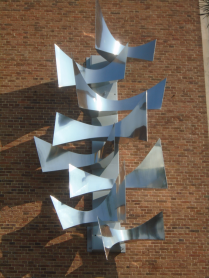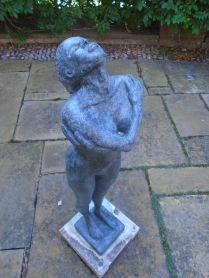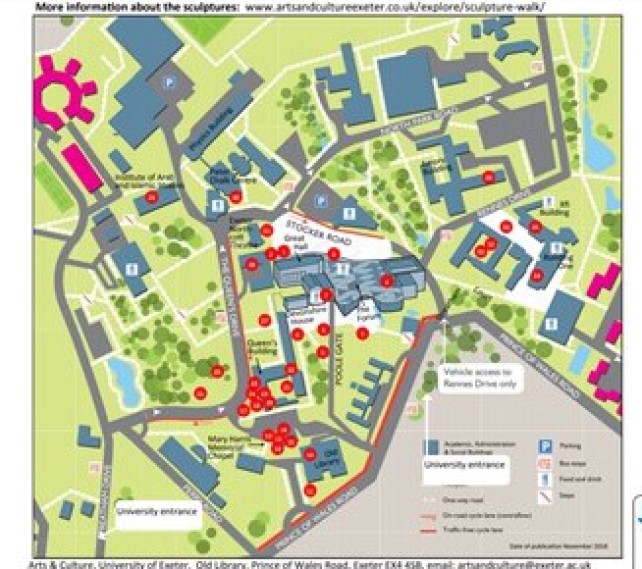
Sculptures in Exeter University Grounds
Thursday, 10 September 2020, proved the perfect day for a walk around the University grounds - not too cold and not too hot and almost no wind. There was tremendous variety in the statues visited - some esoteric and some banal. The University authorities are to be congratulated on maintaining so many and such a variety of artworks.
We traced a gentle path from the bus stop in The Queens Drive around nearby statues and then wandered over to Devonshire House and the Forum. From there we visited sculptures in Stocker Road and Streatham Court. It was a delightful morning and we recommend highly following our route - we hope to include a small map at the bottom of this piece.
1. Figure for Landscape - Dame Barbara Hepworth. Bronze 1960
This abstract evocation of the mother and child icon is a much cherished feature of the Queen's Building lawn. Although the form of this sculpture in bronze is reminiscent of a mother and child, its title is quite deliberate. Dame Barbara related the sculpture to its location in the environment as well as evoking a sense of being part of the landscape.
This figure is recognisable as the work of Dame Barbara and blends naturally with the growing forms of trees and shrubs around it. Its presence on the University campus is entirely due to Canon W Moelwyn Merchant, Professor of English at the University, 1961-1974, whose friendship with the sculptress facilitated the siting of her sculpture on the campus.
2. TIANANMEN SQUARE
Overnight this sculpture was erected by a group of students to memorialise the events in Tiananmen Square, Beijing, on 4 June 1989. It was mainly students who were revolting there – 100,000 of them! – and 300,000 troops were sent to Beijing to quell the demonstration. Estimates are that they killed between several hundred and 10,000 people – there is no official figure.
Students in Exeter, horrified and desperate to do something to show solidarity with the revolutionaries, decided a sculpture would express that solidarity. Speed-learning from sculpture and metal-work students and inspired by Delacroix’s ‘Liberty Leading the People’, they sourced metal from builders and scaffolders and worked day and night to build their creation. Amazingly, they managed to finish it in a weekend.
It was a truly amazing feat to have this produced in secret and assembled here on that night in 1989. That same day candles started to appear at the foot of the statue along with notes, cards, pictures, and a couple of days after that a silent vigil was held by the sculpture attended by students from across the campus. No hunt for its creators ever happened.
A vigil has been held here every June ever since.
3. SKYSAILS by Paul Mount. Obtained through a benefaction from Dr A John Nunn
This artwork was inspired by a childhood passion for sailing ships, stirred up by his Devonian sailor grandfather. The location of SkySails, on the outer wall of Queens Building, reveals a powerful armada of stainless-steel components dancing up the vertical brick exterior of the building. Many believe that the lyrical energy of many of Mount's sculptures displays a preoccupation with the theme of movement and dance.
He taught art in Lagos, Nigeria, for six years and employed a wood-carver from Benin to teach his skills to the students. Before long, thanks to the carver, Mount had found his own path as a sculptor experimenting with smooth, standing forms reminiscent of Barbara Hepworth’s work while also being influenced by the tribal sculptures of the region, which had made a huge impact on him.
A quiet, modest man, Mount exhibited locally, in London and abroad, but his main success lay in the commissions gained through his connections with architects. He also exhibited from home with a sign on the road entering St Just enticing motorists to visit a display of his work at his house !
He was an artist member of the Penwith Society of Arts in St Ives and of the Royal West of England Academy in Bristol. He died, aged 87, in 2009.
4. WALL OF WATER
Exeter University commissioned Water Feature Specialist Tills Innovations to create this simple water wall. Keeping it simple focuses on the key element... the rolling wave of water. Many academics have suggested that the continuous water flow represents perpetual learning.
5. STARGAZER by Janis Ridle
This bronze figure is solid and centred butat the limits of comfortable balance. There is an interplay between the conditions of this gravity and the aspirations and longings that make us look beyond them - in this case to the stars. Her work integrates her experience of drawing the figure with a deep interest in dance and certain myths.
Janis Ridley was born in Co Durham and studied sculpture at Newcastle upon Tyne School of Art and painting at Exeter college of Art, and graduated in 1976 with a BA Hons Fine Art.
6. Tension 1984. Painted mild steel with stainless steel wires.
The artist, Moel Merchant, was encouraged to sculpt by his personal friend, Barbara Hepworth. This piece reveals her influence as itincorporates wires into the space created by the form. It is constructed from painted mild steel with stainless steel wires, which give both a tension and helps to relate opposite parts of the form. The work resembles, perhaps, a mysterious musical instrument.
The artist was Professor of English at the University between 1961 and 1974.
7. Baroness Floella Benjamin by Luke Shepherd
This sculpture commemorates Baroness Floella Benjamin's time here at the University. It includes her hands which give the work a very tactile quality and captures the way she stood as she greeted each student at graduation. She was known for giving every student a hug at graduation, and always listening to any student who had problems or just needed that 'hug'.
To assist in the sculpting of her hands and to reduce her time sitting, a plaster cast was taken. The clay, which weighed 60 kg, was transported very carefully to London from the sculptor's Ashburton studio for each sitting. The final bronze sculpture was poured at the Arch Bronze Foundry in Putney.
Floella's hair was the most challenging part for the sculpture because it was important to give the clay life and lightness and not appear heavy and flat. The sculptor said that Floella was wonderful and immediately made him feel at ease. Therefore bringing the clay to life was easy as Floella had such a buoyant personality.
Floella herself was surprised to see different aspects of herself when seen from different angles. She could also see a resemblance to her father in the clay almost from the second sitting, as well as one of her brothers.
Luke Shepherd, originally from Cardiff and now based in Ashburton, Devon, is one of the few sculptors in the SW creating bronze portrait sculpture. He finishes and patinates all his own bronzes having studied sculpture at Cardiff Art College and the Royal College of Art. He said of his working methods, "A portrait bronze must capture an essence and be instantly recognisable. I try to start with a totally open mind and let the sitter’s personality impress itself upon me.”
8. PARTITION by Roger Leigh
This sculpture was commissioned specifically for its location as a frame to the cornfields
and meadows beyond.
One side (left) is designed to respond to the warm ochre of the cornfields in the distance - although these can no longer be seen due to the luxuriant shrubbery which now obscures the view. On the other side t is green which reflects the lawn beyond it.
Roger Leigh trained as an architect and worked in Barbara Hepworth’s studio in the early 1950s. He returned to St Ives later in the decade and began his full time career as a sculptor and also taught at the Exeter School of Art.
9. Mariners Way II. Edward Crumpton 2015
Made of contemporary materials in the form of a sphere of 1,200 metres of hand knotted rope , this sculpture is a memorial to an ancient walk across Devon, the Mariners’ Way. The 73 mile route is represented by knots reflecting the steps taken in the walk.
The Mariners’ Way Walk is an ancient journey crossing Devon; from Bideford on the North coast to Dartmouth on the South. The journey was undertaken by seamen wishing to change ships. Although the walk was treacherous, the shipping industries were of such importance that this journey proved lucrative.
10. Peacock
This sculpture was designed by members of the University of Exeter’s Art Society and built in collaboration with local Devon artist, Ed Crumpton. Based on the theme of sustainability, the sculpture is formed from materials used in the construction of The Forum and aims to promote recycling. As well as an animal of beauty, the process of replenishment in the peacock’s feathers mirrors the construction of the Forum project, converting old to new. This is fundamentally what the sculpture is; old hoardings have been used to create something new and beautiful.
The imposing structure of the peacock in display immediately captures the viewer’s attention. The metal structure reflects the light, colour and movement of the sculpture’s environment, creating a sense of energy within the piece. The first band of feathers provides the grounding to the following two layers, alluding to the extensions to the old university buildings; The Forum itself and the extension of the Library. Furthermore, the two layers, adorned with glass beads, represent the two-year time scale in which the Forum was constructed. The curve of each feather acts to complement the architecture of the building.
11. White Entwined
This was commissioned by the University and the sculptor, Deborah Duffin, says "I sought to create a sculpture which would work with the tree: a piece with the feeling of a living organism which became part of its host, rather like the Wisteria already at home on its trunk; yet at the same time with a presence of its own.
The pale colours of the shape were selected to show up against the background of greenery and the tail (entwined around the tree) allowed for a gradual change towards the colour of the bark – a mixture of pinks, greens, browns and greys.
Deborah Duffin says: “A lifelong concern for our environment leads me to seek out discarded materials which would otherwise go into landfill – wire, found objects, waste packaging - the detritus of our profligate world. I choose malleable materials and using repetitive processes – twisting, tying, cutting, bending - I set up a meditative space in which to observe my process. I mimic nature’s processes, while transcending the basic nature of the materials”.
12. Alexander Beleschenko. Toughened glass, digitally printed in 2011.
This stunning artwork was commissioned specifically for the University’s Forum. It is set into glass panes forming the front and the back of the building. The sources of inspiration for Beleschenko's work are all based on the University’s environs and some of its research work.
Each of the forms that populate the glass have their own alphabet of colours, giving a broad range of hues through cool to warm. The colours in the artwork form a code and all the words relate to the University. The text is broken up into blocks and these are themed.
Alexander Beleschenko is inspired by creating positive environments with light and colour. He was born in Corby in 1951 and is an Honorary Fellow of the Royal Institute of British Architects. He works from his architectural glass studio in Swansea.
14. By Another Ocean III. Peter Randall-Page.
During the past 25 years, Peter Randall-Page’s sculptures, drawings and prints have gained him an international reputation He was a member of the design team for the Education Resource Centre at the Eden Project in Cornwall, influencing the design of the building by incorporating an enormous granite sculpture, Seed, at its heart. His work is held in public and private collections all over the world.
His practice has always been informed and inspired by the study of nature and its impact on our emotions. In recent years he has become increasingly concerned with the underlying principles determining growth and the forms it produces. He believes that “geometry is the theme on which nature plays her infinite variations..”
This sculpture is part of a long series of works exploring the way in which a single form can evoke compressed complexity through linear patterns. The carved ‘loops’ are concentric and imply the possibility for division or extension if they were to unravel and open up. The most potent areas of expression in a sculpture can be where one form abuts and touches another. This happens over the entire surface of this piece.
The carving is understated and the hope is that its presence is greater than its physical dimensions through a sense of compressed potential energy, like a seed.
13. The Minoprio Fountain. Vivien Rhys Pryce.
This charming piece was donated to the University in 1988 and was set up to promote water sculptures in public settings. Iti s named after Anthony Minoprio, an architect on the committee of the Constance Fund, which donated this artwork.
The sculptures of Vivien ap Rhys Pryce are based on the great tradition of figurative art. Human figures have been her main source of inspiration and they form the themes of many of her sculptures – she often sculpts dancers.
Her works have been shown at several commercial galleries, notably the Jonathan Poole Gallery, and she has also regularly exhibited at the Royal Academy in London, at the Royal Glasgow Institute of the Fine Arts, the Royal West of England Academy and with the New English Art Club.
15. Seagull. Barbara Jones
This piece strikingly evokes the form and movement of a seagull and was set into the Streatham Court patio for contemplation. Its location near the beach stone fountain is a reminder of the close proximity of the sea.
Barbara Jones was a student at the Exeter College of Art from 1966 to 1969.
16. Takamanda
This exhibit was part of a 30-piece art trail of fibreglass gorillas which appeared around Exeter and Torbay in 2013, a project initiated by Paignton Zoo. He is named after Takamanda National Park in Cameroon, the natural home of the Cross River gorilla.
The design was created by a student at the University, Meriel Royal. Her inspiration was the idea of the gorilla making stops around the world, collecting stamps of other endangered animals before arriving in Exeter. The winning design was painted in front of students, staff and visitors, by local artist vin Jelly (aka Kevin Jones) and was purchased by the University at auction.
.
The Director of Campus Services said in 2013, "We wanted to bring Takamanda back to Exeter because the gorilla is unique to us - it was designed by one of our students and is bespoke to the University. We're also delighted to show our support for Paignton Zoo's Cross River Gorilla Project".
LIST OF ABOVE SCULPTURES SHOWING MAP REFERENCE
| 1. Dame Barbara Hepworth | 26 | 9. Mariners Way II | 5 | |
| 2. Tiananman Square | 25 | 10. Peacock | 6 | |
| 3. Skysails | 17 | 11. White Entwined | 9 | |
| 4. Water Wall | 12. Beleschenko | 3 | ||
| 5. Stargazer By Janis Ridle | 24 | 13. Msinoprio fountain | 30 | |
| 6. Tension 1984 | 3 | 14. By Another Ocean III | 31 | |
| 7. Baroness Floella Benjamin | 27 | 15. Seagull | 33 | |
| 8. Partition by Roger Leigh | 8 | 16. Takamanda | 32 |
NOTE: A clearer copy of this map can be obtained using the following link:
https://assets.ctfassets.net/4h5a26cfixk0/6nZZLazNKvD0ulEjfyEfqW/3edc5767e333eb7d9731bcd9b2eac277/2019_v12aSculpture_Walk_Leaflet_07_19__6_.pdf



